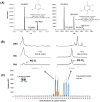Novel mechanism of metabolic co-regulation coordinates the biosynthesis of secondary metabolites in Pseudomonas protegens
- PMID: 28262092
- PMCID: PMC5395296
- DOI: 10.7554/eLife.22835
Novel mechanism of metabolic co-regulation coordinates the biosynthesis of secondary metabolites in Pseudomonas protegens
Abstract
Metabolic co-regulation between biosynthetic pathways for secondary metabolites is common in microbes and can play an important role in microbial interactions. Here, we describe a novel mechanism of metabolic co-regulation in which an intermediate in one pathway is converted into signals that activate a second pathway. Our study focused on the co-regulation of 2,4-diacetylphloroglucinol (DAPG) and pyoluteorin, two antimicrobial metabolites produced by the soil bacterium Pseudomonas protegens. We show that an intermediate in DAPG biosynthesis, phloroglucinol, is transformed by a halogenase encoded in the pyoluteorin gene cluster into mono- and di-chlorinated phloroglucinols. The chlorinated phloroglucinols function as intra- and inter-cellular signals that induce the expression of pyoluteorin biosynthetic genes, pyoluteorin production, and pyoluteorin-mediated inhibition of the plant-pathogenic bacterium Erwinia amylovora. This metabolic co-regulation provides a strategy for P. protegens to optimize the deployment of secondary metabolites with distinct roles in cooperative and competitive microbial interactions.
Keywords: Pseudomonas protegens; biochemistry; infectious disease; metabolic co-regulation; microbiology; secondary metabolite.
Conflict of interest statement
The authors declare that no competing interests exist.
Figures


















Similar articles
-
Phloroglucinol Derivatives in Plant-Beneficial Pseudomonas spp.: Biosynthesis, Regulation, and Functions.Metabolites. 2021 Mar 20;11(3):182. doi: 10.3390/metabo11030182. Metabolites. 2021. PMID: 33804595 Free PMC article. Review.
-
Phloroglucinol functions as an intracellular and intercellular chemical messenger influencing gene expression in Pseudomonas protegens.Environ Microbiol. 2016 Oct;18(10):3296-3308. doi: 10.1111/1462-2920.13043. Epub 2015 Oct 14. Environ Microbiol. 2016. PMID: 26337778
-
Phloroglucinol mediates cross-talk between the pyoluteorin and 2,4-diacetylphloroglucinol biosynthetic pathways in Pseudomonas fluorescens Pf-5.Mol Microbiol. 2011 Jul;81(2):395-414. doi: 10.1111/j.1365-2958.2011.07697.x. Epub 2011 May 26. Mol Microbiol. 2011. PMID: 21564338
-
Interspecies signaling modulates the biosynthesis of antimicrobial secondary metabolites related to biological control activities of Pseudomonas fluorescens 2P24.Microbiol Spectr. 2025 Mar 4;13(3):e0188624. doi: 10.1128/spectrum.01886-24. Epub 2025 Feb 3. Microbiol Spectr. 2025. PMID: 39898669 Free PMC article.
-
Biosynthesis of phloroglucinol compounds in microorganisms--review.Appl Microbiol Biotechnol. 2012 Jan;93(2):487-95. doi: 10.1007/s00253-011-3712-6. Epub 2011 Nov 19. Appl Microbiol Biotechnol. 2012. PMID: 22101786 Review.
Cited by
-
Nonribosomal peptide synthetase biosynthetic clusters of ESKAPE pathogens.Nat Prod Rep. 2017 Aug 2;34(8):981-1009. doi: 10.1039/c7np00029d. Nat Prod Rep. 2017. PMID: 28642945 Free PMC article. Review.
-
Loci Encoding Compounds Potentially Active against Drug-Resistant Pathogens amidst a Decreasing Pool of Novel Antibiotics.Appl Environ Microbiol. 2019 Nov 14;85(23):e01438-19. doi: 10.1128/AEM.01438-19. Print 2019 Dec 1. Appl Environ Microbiol. 2019. PMID: 31540982 Free PMC article.
-
Effects of Phosphonate Herbicides on the Secretions of Plant-Beneficial Compounds by Two Plant Growth-Promoting Soil Bacteria: A Metabolomics Investigation.ACS Environ Au. 2021 Nov 18;2(2):136-149. doi: 10.1021/acsenvironau.1c00030. eCollection 2022 Mar 16. ACS Environ Au. 2021. PMID: 37101584 Free PMC article.
-
Context matters: assessing the impacts of genomic background and ecology on microbial biosynthetic gene cluster evolution.mSystems. 2025 Mar 18;10(3):e0153824. doi: 10.1128/msystems.01538-24. Epub 2025 Feb 24. mSystems. 2025. PMID: 39992097 Free PMC article. Review.
-
Phloroglucinol Derivatives in Plant-Beneficial Pseudomonas spp.: Biosynthesis, Regulation, and Functions.Metabolites. 2021 Mar 20;11(3):182. doi: 10.3390/metabo11030182. Metabolites. 2021. PMID: 33804595 Free PMC article. Review.
References
-
- Baehler E, Bottiglieri M, Péchy-Tarr M, Maurhofer M, Keel C. Use of green fluorescent protein-based reporters to monitor balanced production of antifungal compounds in the biocontrol agent Pseudomonas fluorescens CHA0. Journal of Applied Microbiology. 2005;99:24–38. doi: 10.1111/j.1365-2672.2005.02597.x. - DOI - PubMed
-
- Bergmann S, Funk AN, Scherlach K, Schroeckh V, Shelest E, Horn U, Hertweck C, Brakhage AA. Activation of a silent fungal polyketide biosynthesis pathway through regulatory cross talk with a cryptic nonribosomal peptide synthetase gene cluster. Applied and Environmental Microbiology. 2010;76:8143–8149. doi: 10.1128/AEM.00683-10. - DOI - PMC - PubMed
-
- Blackman AJ, Matthews DJ. Halogenated phloroglucinols from Rhabdonia verticillata. Phytochemistry. 1982;21:2141–2142. doi: 10.1016/0031-9422(82)83072-0. - DOI
MeSH terms
Substances
LinkOut - more resources
Full Text Sources
Other Literature Sources

